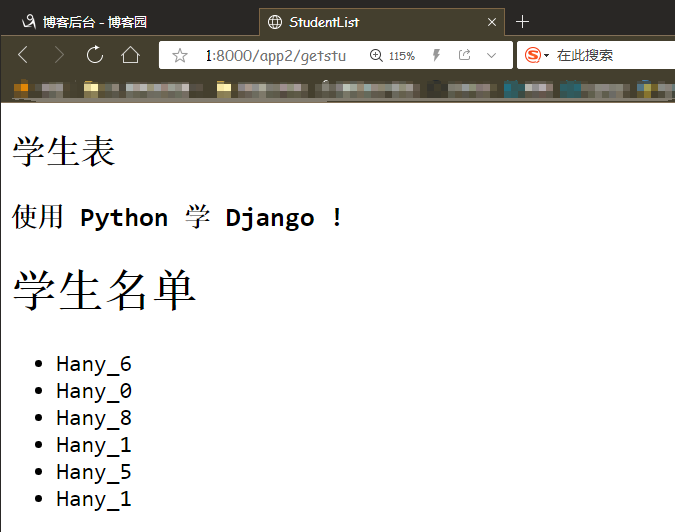在 views 中实现对数据库的添加和读取数据库
添加数据
对象 = models 中创建的类名()
对象.列名 = '字段值'
对象.save() 进行保存
return HttpResponse('提示信息')
def add_student(request):
stu = Student()
stu.s_name = 'Hany_%d'%(random.randrange(10))
stu.save()
return HttpResponse("添加成功,添加的姓名为 %s"%(stu.s_name))
在 urls 中的 urlpatterns 中进行注册
url(r'addstu',views.add_student),
读取数据 对象 = models 中的类名.objects.all() 来获取objects 的接口 创建 context (字典对象)传递给 templates 中的 html 文档 context 的键是html 中需要使用的,值是需要显示的 context 是 from django.shortcuts import render 函数的参数
context = {
'键':值,
'键2':值2
}
def get_student(request):
stus = Student.objects.all()
# 获取所有学生,objects 操作的入口
context = {
'hobby':'使用 Python 学 Django !',
'stus':stus
}
# context 是一个字典,用来与 html 代码进行关联
return render(request,'stu_list.html',context = context)
注:stu_list.html 是在 templates 中创建的 stu_list.html 文档
在 HTML 代码中显示
使用 {{view.py 函数中传递过来的 context 参数的键}} 即可访问
如果需要显示全部的数据,需要进行遍历
for 循环
{{% for 对象 in 键%}}
<标签名>{{对象.表的列名}}</标签名>
{{endfor}}
注:表的列名:models 的类中定义的属性
<!DOCTYPE html>
<html lang="en">
<head>
<meta charset="UTF-8">
<title>StudentList</title>
</head>
<body>
<h2>学生表</h2>
<h3> {{hobby}}</h3>
<h1>学生名单</h1>
<ul>
{% for stu in stus %}
<li>{{ stu.s_name }}</li>
{% endfor %}
</ul>
</body>
</html>




2020-05-07